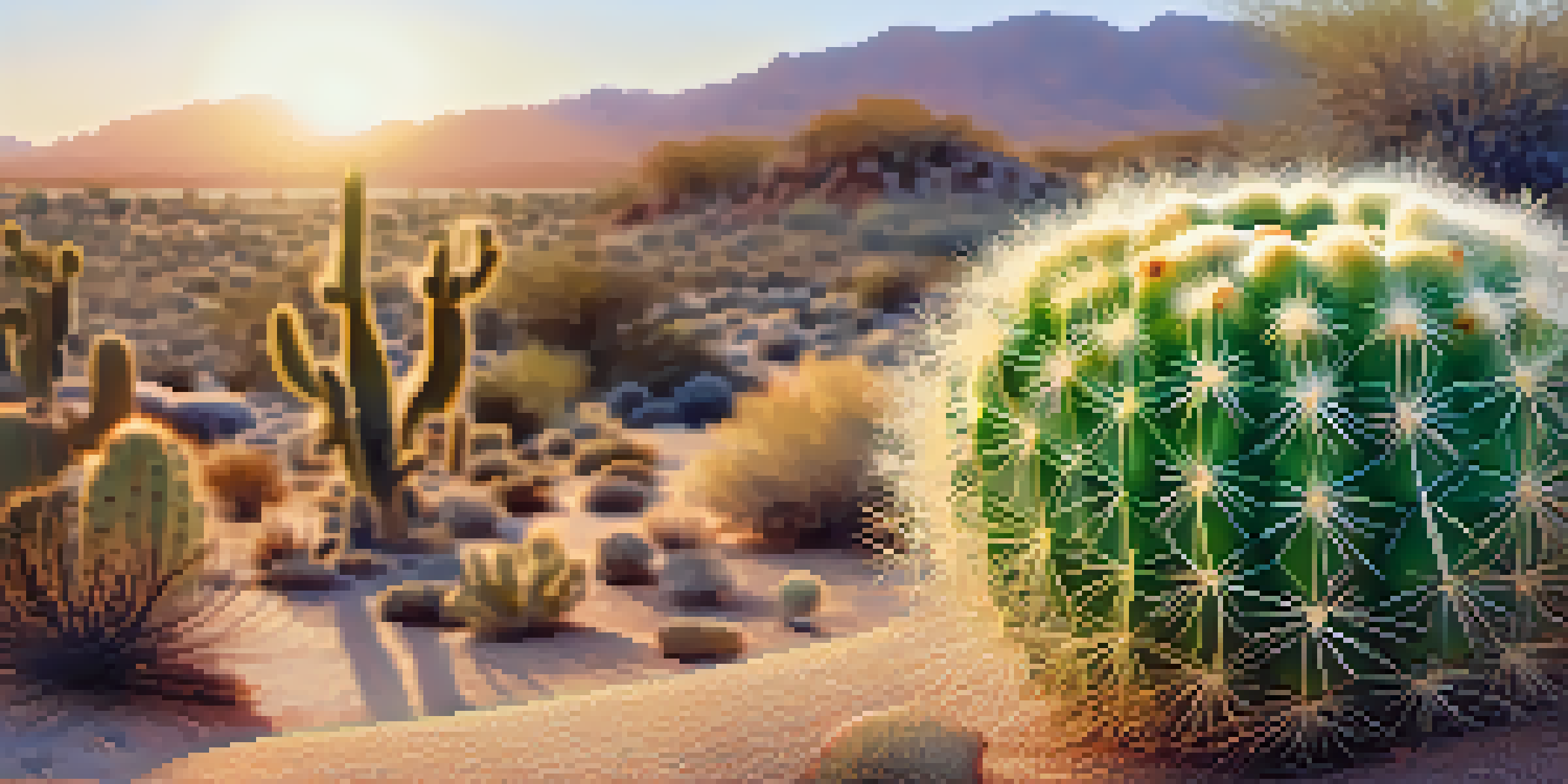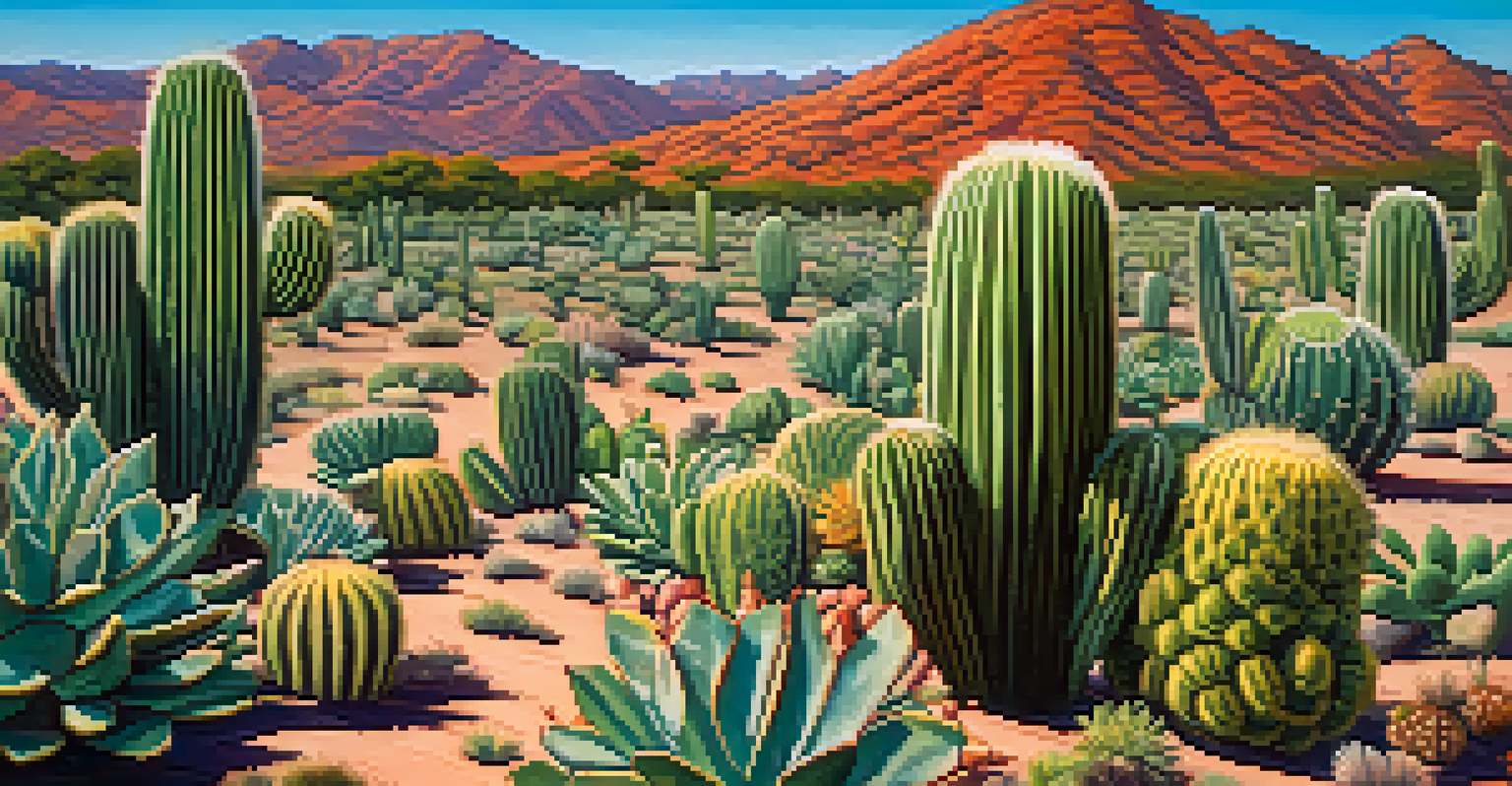The Impact of Overharvesting on Peyote Genetic Diversity

Understanding Peyote and Its Cultural Significance
Peyote, a small cactus native to North America, is renowned for its psychoactive properties, primarily due to the compound mescaline. For centuries, it has held deep cultural significance for Indigenous peoples, particularly in spiritual and religious practices. These communities view peyote not just as a plant, but as a vital part of their identity and heritage.
The preservation of our environment is not a task for the future, but a responsibility we must embrace today.
In ceremonies, peyote is often used to facilitate introspection and connection with the spirit world, making it a sacred element in many Indigenous cultures. The ritualistic use of peyote underscores its importance beyond mere consumption, highlighting the need for respect and preservation of this unique species. As the demand for peyote grows, understanding its cultural value becomes increasingly important.
However, the rising popularity of peyote in both traditional and modern contexts has led to concerns about its sustainability. As more people seek to experience its effects, the pressure on peyote populations intensifies, making it crucial to examine the implications of overharvesting.
What is Overharvesting? A Closer Look
Overharvesting refers to the excessive collection of a species, leading to its decline and potential extinction. In the case of peyote, this often occurs due to the increased demand for its psychoactive properties, driving collectors to harvest more than what is sustainable. This practice can disrupt local ecosystems and diminish genetic diversity, which is essential for the plant's resilience.

When plants are overharvested, not only do we lose individual specimens, but we also risk losing the genetic variations that allow for adaptability. Genetic diversity is crucial for species survival, enabling them to adapt to changing environments, pests, and diseases. In the case of peyote, a reduction in genetic diversity could threaten its long-term viability.
Cultural Importance of Peyote
Peyote is deeply valued by Indigenous peoples for its role in spiritual and cultural practices.
Moreover, overharvesting can lead to a phenomenon known as 'genetic bottlenecking,' where a small number of individuals contribute to the next generation. This limits genetic variation and can have cascading effects on the species' ability to thrive in the wild.
The Consequences of Reduced Genetic Diversity
Reduced genetic diversity in peyote can lead to several ecological and biological consequences. For one, it can make the species more susceptible to diseases and environmental changes, such as shifts in climate or habitat loss. A genetically uniform population may struggle to survive if faced with new challenges, jeopardizing not only the plant but also the ecosystems that depend on it.
In every walk with nature, one receives far more than he seeks.
Additionally, diminished genetic diversity can impact the plant's ability to reproduce and grow. If peyote populations become too similar, they may face challenges during pollination and seed development, further threatening their survival. This cycle of decline can become self-perpetuating, as fewer plants lead to even less genetic diversity over time.
The implications extend beyond the species itself; they can affect the Indigenous communities that rely on peyote for cultural and spiritual practices. As the plant's availability dwindles, it can undermine cultural rituals, placing additional strain on these communities and their heritage.
The Role of Conservation Efforts
Conservation efforts play a critical role in preserving peyote and its genetic diversity. Organizations and Indigenous groups are working together to promote sustainable harvesting practices, ensuring that peyote can continue to thrive in its natural habitat. These initiatives not only focus on protecting the plant but also on educating collectors about its cultural significance and the importance of responsible harvesting.
One effective approach includes establishing protected areas where peyote can grow freely without the threat of overharvesting. By creating sanctuaries or reserves, we can safeguard existing populations and allow them to regenerate. Furthermore, these areas can serve as research sites to study genetic diversity and develop strategies for its preservation.
Threat of Overharvesting
Increased demand for peyote has led to overharvesting, threatening its sustainability and genetic diversity.
Engaging local communities in conservation efforts fosters a sense of ownership and responsibility, encouraging sustainable practices that benefit both the plant and the people who rely on it. By valuing peyote’s cultural heritage, we can help ensure its survival for future generations.
Sustainable Harvesting Practices for Peyote
Implementing sustainable harvesting practices is essential to combating the effects of overharvesting. This involves collecting peyote in a way that allows for the plant's regeneration, such as taking only a fraction of the population and ensuring that the remaining plants can continue to thrive. Techniques like selective harvesting can help balance the demand for peyote with its conservation.
Another approach is to educate collectors about the life cycle of peyote, emphasizing the importance of allowing the plant time to recover after harvesting. By understanding when and how to harvest responsibly, collectors can minimize their impact on existing populations. Promoting a culture of respect for the plant is vital for its long-term survival.
Additionally, collaboration between Indigenous communities, conservationists, and policymakers can help develop guidelines and regulations that protect peyote from overharvesting. These collective efforts can lead to more sustainable practices that honor both the plant and the traditions surrounding its use.
The Importance of Genetic Research
Genetic research plays a pivotal role in understanding the impact of overharvesting on peyote's genetic diversity. By studying the genetic makeup of different populations, scientists can identify variations that contribute to resilience and adaptability. This knowledge is crucial for developing effective conservation strategies and promoting sustainable harvesting practices.
Research can also inform breeding programs aimed at increasing genetic diversity in peyote populations. By cultivating genetically diverse plants, we can enhance the species' ability to withstand environmental changes and diseases. Such initiatives can be instrumental in restoring populations that have been affected by overharvesting.
Need for Conservation Efforts
Collaborative conservation initiatives and sustainable harvesting practices are essential for preserving peyote and its cultural significance.
Moreover, genetic research can help raise awareness about the challenges facing peyote and the importance of preserving its diversity. By sharing findings with the public and policymakers, we can foster a greater understanding of the plant's significance and the need for sustainable practices.
Conclusion: The Path Forward for Peyote Conservation
The impact of overharvesting on peyote genetic diversity is a pressing issue that requires urgent attention. By recognizing the cultural, ecological, and biological significance of this plant, we can take meaningful steps toward its preservation. Sustainable harvesting practices, conservation efforts, and genetic research are all critical components of this journey.
As we move forward, it is essential to foster collaboration among Indigenous communities, conservationists, and researchers to create a comprehensive approach to peyote conservation. By working together, we can ensure that peyote continues to thrive in its natural habitat, honoring both its cultural heritage and ecological importance.

Ultimately, the future of peyote lies in our hands. By prioritizing its sustainability and genetic diversity, we can protect this invaluable resource for generations to come, ensuring that its spiritual and cultural significance endures.